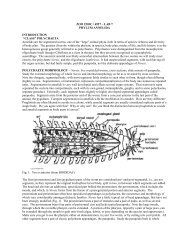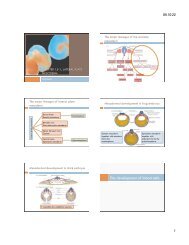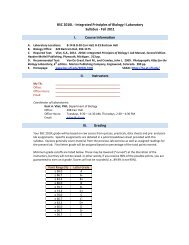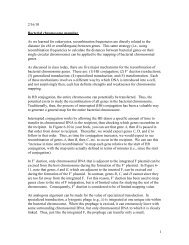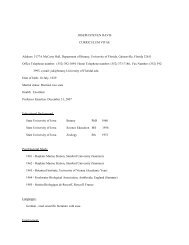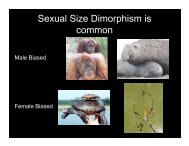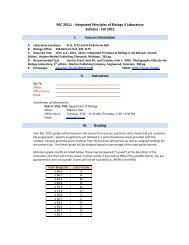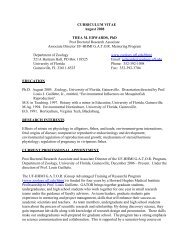You also want an ePaper? Increase the reach of your titles
YUMPU automatically turns print PDFs into web optimized ePapers that Google loves.
Circ.: Lack blood pigment in most - as have large gills and low metabolic rates. However hemoglobin in Arcidae– blood cockles.Nerv./sens.: In mollusks in general photoreceptors on head microvillar elsewhere on body ciliary & thus all bivalvephotoreceptors ciliary (cf.scallop eyes).Repr.: Most dioceous, free spawning. Dwarf males in few. Gametes out via nephridia in protobranchs, viaspecialized gonoducts.Development: Trochophore larva first, then test-cell larva in protobranchs (shell developing internally); veligers inlamellibranchs - always w/ 2 shells dev. as 2 areas of calcification. Glottidia larva of many unionids - parasiticon fish. Metamorphosis: shed velum.Diversity: see FHL lecture notes.Iso – hetero – mono-myarianByssate, endobyssate, cementedSubclass NautiloideaSubclass ColeoideaOrder SepioideaOrder TeuthoideaSuborder Myopsida (loliginids etc)Suborder OegopsidaOrder VampyromorphaOrder OctopodaSuborder CirrataSuborder IncirrataCEPHALOPODAVampiroteuthis video: http://www.youtube.com/watch?v=q5ZQH2Uzpew&feature=related~700 living, >10K fossil species; U Cambrian-RecentAll marine; pelagic radiation, all carnivorous/scavengers, some mostly benthic now; major radiation in deep sea,bathypelagic and deep benthic alsoMedium-large: 2 cm – 20 mCephalopods are mollusks that have shells with chambers and siphuncle; allows gas secretion thus buoyancy withshell. Nautilus modern model.Evolutionary history: gradual reduction and, in some, loss of shell.Body plan- elongation along visceral (secondary) molluscan axis: cephalopodium – visceropallium- thus head ventral, tip of body dorsal- viscera enclosed in shell, or in muscularized mantle- foot turns into funnel- arms developed around mouth – outgrowths of head; numerous in Nautilus, 8-10 in coleoids with suckers (andhooks in some)- ink sac – escape; some deep with bioluminescent inkShell- primitively external, chambered, with siphuncle – key innovation on molluscan shell allowing invasion of pelagicrealm- complex evolutionary history; major variation through fossil record in coiling, emphases on different parts ofshell, etc- in living cephs Nautilus w/ plesiomorphic shell, and the only species with proper external shell





